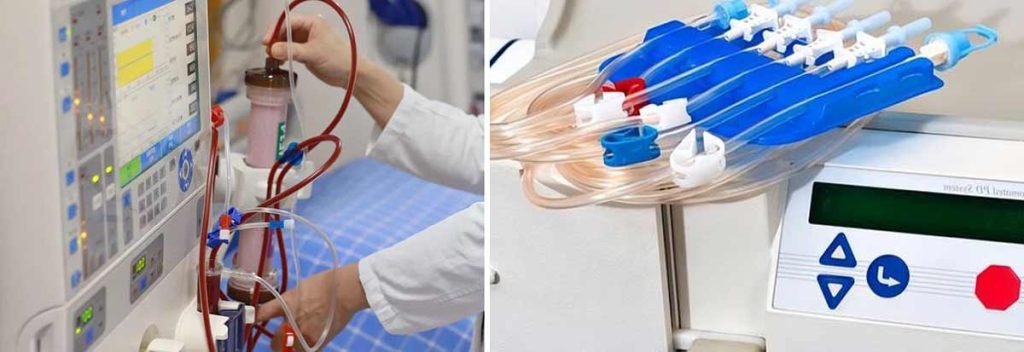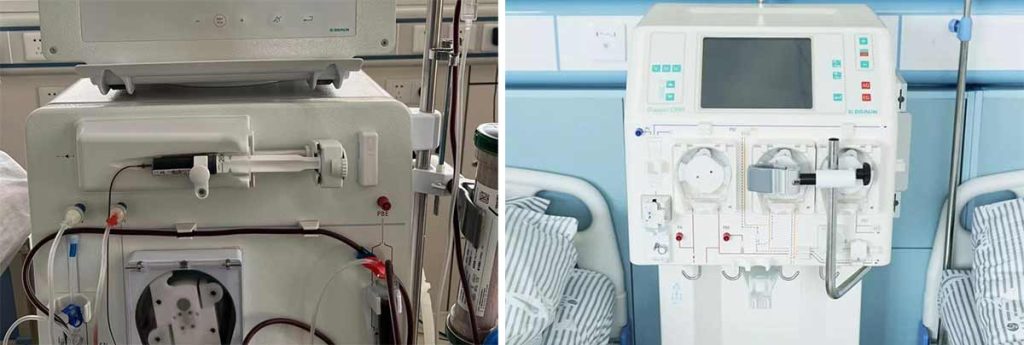

Blood clotting during dialysis presents a significant challenge for patients and healthcare providers. This issue arises due to factors such as stenosis, thrombosis, and interactions with the dialysis machine. Studies reveal that clotting occurs in 19.4% of hemodialysis sessions, while bleeding affects 15.4% of patients. Vascular access complications, including stenosis or thrombosis, further reduce blood flow rates, increasing the likelihood of clot formation. Additionally, procoagulant conditions in dialysis patients elevate D-dimer levels, signaling thrombus development. These factors highlight the importance of understanding and addressing the causes of clotting to ensure effective treatment and patient safety.
Key Takeaways
- Blood clots happen in 19.4% of dialysis sessions. It is important to know why to keep patients safe.
- Stenosis, or when blood vessels get narrow, raises clot risks. It slows blood flow where the dialysis happens.
- Keeping good blood flow in dialysis machines stops clots. Checking and fixing machines often can help.
- Patients should check their blood pressure and follow dialysis plans. This lowers clot risks and makes treatment better.
- Drinking water and eating healthy can help blood flow well. These habits lower the chance of clots.
Causes of Blood Clotting During Dialysis
Stenosis and Its Role in Blood Clotting
Stenosis, or the narrowing of blood vessels, plays a significant role in blood clotting during dialysis. This condition often affects arteriovenous (AV) fistulas and grafts, which are critical access points for treatment. When blood vessels narrow, blood flow decreases, leading to increased pressure within the access site. This environment promotes clot formation, disrupting the dialysis process.
Clinical data highlights that stenosis is a common cause of access dysfunction. For example, arteries feeding the AV fistula or graft may narrow, slowing blood flow and reducing the efficiency of dialysis. Over time, this can create a cycle where reduced blood flow exacerbates clotting, potentially leading to complete blockage.
| Evidence Description | Impact on Blood Clotting |
|---|---|
| Stenosis narrows blood vessels, reducing blood flow and increasing pressure. | Contributes to clot formation in dialysis access points. |
| Reduced blood flow rates due to stenosis can create a cycle of clot formation. | Exacerbates initial problems of access dysfunction. |
Thrombosis and Dialysis Access Points
Thrombosis, or the formation of blood clots, is another major contributor to complications during dialysis. Studies show that thrombosis accounts for 80%-85% of arteriovenous access failures. Procoagulant conditions in dialysis patients often lead to clotting and microemboli, which can obstruct blood flow. Elevated D-dimer levels, a marker of thrombus formation, are frequently observed in these patients.
Thrombosis can also occur suddenly, especially when blood pressure drops during treatment. This sudden change increases the risk of clotting at vascular access points, potentially leading to closure. Chronic thrombotic burdens in hemodialysis patients further highlight the need for careful monitoring and management of these risks.
Machine-Related Factors in Blood Clotting
Interactions with the dialysis machine can also contribute to blood clotting. Blood flow rate plays a critical role in this process. Lower flow rates are strongly associated with higher rates of clotting within the dialysis circuit. Hemodynamic instability, such as hypotension or fluid overload, can further disrupt blood flow, increasing the likelihood of clot formation.
Additionally, components of the dialysis machine, including the dialyzer, are susceptible to thrombotic events. Proper calibration and monitoring of the machine are essential to minimize these risks. Ensuring optimal blood flow rates and addressing any mechanical issues can significantly reduce the chances of clotting during treatment.
Patient-Specific Factors Contributing to Clotting

Certain patient-specific factors significantly increase the risk of blood clotting during dialysis. These factors often stem from underlying health conditions, treatment patterns, and individual responses to dialysis procedures.
Low blood pressure during dialysis is a common issue that correlates with a higher likelihood of clot formation. When blood pressure drops, blood flow through the dialysis access points slows down, creating an environment conducive to clotting. Patients who experience frequent episodes of hypotension during treatment may face a greater risk of vascular complications.
The frequency of hemodialysis sessions and the blood flow rate during treatment also play a critical role. A study involving 1,010 hemodialysis procedures on 175 patients revealed a significant association between the total number of treatments and clotting incidents. Lower blood flow rates, often caused by machine settings or patient-specific conditions, further exacerbate this issue.
Other contributing factors include the length of hospital stays and serum creatinine levels at admission. Patients with prolonged hospitalizations or elevated creatinine levels may experience changes in blood composition, increasing clotting risks. Additionally, the use of anticoagulants or antiplatelet medications can influence clotting tendencies. While these medications aim to prevent clots, improper dosing or individual reactions may lead to complications.
Tip: Dialysis patients can reduce clotting risks by closely monitoring their blood pressure and adhering to prescribed dialysis schedules. Regular communication with healthcare providers ensures that treatment plans address individual needs effectively.
Understanding these patient-specific factors allows healthcare teams to tailor interventions, improving dialysis outcomes and minimizing complications.
How Blood Clotting Affects Dialysis?
Disruption of Blood Flow and Dialysis Efficiency
Blood clotting during dialysis significantly disrupts blood flow, reducing the efficiency of the treatment. When clots form, they obstruct the smooth passage of blood through the dialysis machine, leading to incomplete filtration. This disruption can result in the accumulation of toxins in the patient’s bloodstream, which dialysis aims to remove.
- A study involving 1,010 hemodialysis procedures found that clotting occurred in 3.9% of sessions, while bleeding incidents were noted in 2.9%.
- Clotting affected 19.4% of participants, highlighting its impact on treatment outcomes.
- A strong correlation was observed between blood flow rates and clotting incidents, emphasizing the importance of maintaining optimal flow during dialysis.
These findings underscore the need for careful monitoring of blood flow rates to prevent clot formation and ensure effective dialysis sessions.
Damage to Dialysis Access Points
Blood clots can cause significant damage to dialysis access points, such as arteriovenous (AV) fistulas or grafts. These access points are vital for the treatment process, and any obstruction can lead to severe complications. Low blood pressure during dialysis increases the likelihood of clots forming at these sites. Patients experiencing frequent hypotension are twice as likely to develop clotted fistulas.
Thrombosis in AV fistulas or grafts often results in reduced or completely halted blood flow. This damage requires immediate intervention to restore functionality and prevent further complications. Regular monitoring of access points and prompt treatment of clots are essential to minimize long-term damage.
Health Risks Associated with Blood Clotting
Blood clotting during dialysis poses several health risks to patients. Clots can lead to vascular complications, increased hospitalization, and even life-threatening conditions. Data from 1,010 hemodialysis procedures revealed that clotting incidents were linked to factors such as prolonged hospital stays, elevated serum creatinine levels, and uremic symptoms. These conditions can exacerbate the patient’s overall health status.
Clotting affected 19.4% of participants in the study, while bleeding incidents were observed in 15.4%. The association between the frequency of dialysis sessions and clotting incidents further highlights the need for individualized treatment plans. Addressing these risks through preventive measures and timely interventions can improve patient outcomes and reduce complications.
Preventing Blood Clotting During Dialysis
Medical Interventions to Prevent Clotting
Medical interventions play a crucial role in reducing the risk of blood clotting during dialysis. Anticoagulants, such as heparin, are commonly administered to prevent clots from forming in the dialysis circuit. These medications work by thinning the blood, ensuring smooth flow through the machine. However, healthcare providers must carefully monitor dosage to avoid excessive bleeding, which is one of the common side effects of anticoagulant use.
In some cases, dialysis patients may require adjustments to their medication regimen. For example, those with a history of clotted dialysis access may benefit from alternative anticoagulants or additional therapies. Regular blood tests help assess clotting tendencies and guide treatment decisions. These proactive measures reduce the likelihood of circuit clotting and improve overall dialysis outcomes.
Procedural Strategies for Clot Prevention
Specific procedural strategies can minimize the occurrence of blood clots during dialysis. Maintaining optimal blood flow rates is essential. Dialysis machines must be calibrated correctly to ensure consistent flow, as low rates increase the risk of clot formation. Regular machine maintenance also prevents mechanical issues that could disrupt treatment.
Healthcare teams often monitor patients for signs of low blood pressure during dialysis sessions. A Stanford-led study found that frequent episodes of low blood pressure doubled the risk of clotted dialysis access. By addressing this issue promptly, clinicians can prevent complications. Additionally, using advanced dialyzers with clot-resistant materials has shown promise in reducing dialysis side effects related to clotting.
Patient Lifestyle Adjustments to Reduce Risk
Patients can adopt lifestyle changes to lower their risk of blood clotting. Staying hydrated helps maintain proper blood flow, reducing the chances of clots forming. Adhering to prescribed dialysis schedules ensures consistent treatment, which minimizes complications. Patients should also monitor their blood pressure regularly, as fluctuations can increase clotting risks.
Dietary adjustments may further support clot prevention. Consuming foods rich in omega-3 fatty acids, such as fish or flaxseeds, promotes healthy blood circulation. Dialysis patients with kidney failure should consult their healthcare provider to create a diet plan tailored to their needs. These steps, combined with medical and procedural strategies, provide a comprehensive approach to managing dialysis side effects effectively.
Managing Blood Clotting When It Occurs
Immediate Actions for Blood Clots During Dialysis

When blood clots form during dialysis, immediate action is essential to prevent further complications. Healthcare providers often stop the dialysis session to assess the situation. They may flush the dialysis circuit with saline to dissolve smaller clots and restore blood flow. If the clot persists, they might administer anticoagulants like heparin to break it down. These steps help minimize the risk of circuit clotting and ensure patient safety.
Monitoring the patient’s vital signs is another critical step. Sudden changes in blood pressure or heart rate can indicate complications related to the clot. In severe cases, healthcare teams may need to replace the dialysis machine’s tubing or dialyzer to resume treatment effectively. Quick intervention reduces the likelihood of long-term damage to dialysis access points.
Note: Patients should report any unusual symptoms, such as pain or swelling near the access site, to their healthcare provider immediately. Early detection can prevent serious side effects.
Long-Term Solutions for Recurrent Clotting Issues
For patients experiencing recurrent blood clots during dialysis, long-term solutions focus on addressing underlying causes and minimizing risk factors. Regular monitoring of dialysis access points, such as arteriovenous fistulas or grafts, helps detect early signs of stenosis or thrombosis. Healthcare providers may recommend angioplasty or surgical interventions to improve blood flow and reduce clotting risks.
Adjusting anticoagulant therapy is another effective strategy. Patients with a history of clotting may benefit from personalized medication plans. Regular blood tests ensure the correct dosage, reducing the risk of both clotting and bleeding, which are common side effects of anticoagulants.
Lifestyle changes also play a significant role in managing recurrent clotting. Patients with kidney failure should maintain a balanced diet and stay hydrated to support healthy blood circulation. Adhering to prescribed dialysis schedules and monitoring blood pressure can further reduce the risk of side effects. These proactive measures improve treatment outcomes and enhance the quality of life for individuals with end stage renal disease.
Conclusion
Blood clotting during dialysis remains a manageable complication with the right approach. Early detection and proactive management significantly improve outcomes. Studies show that clotting occurs in 19.4% of hemodialysis sessions, while bleeding affects 15.4% of patients. Factors like blood flow rate and session frequency strongly influence these incidents. Addressing causes such as stenosis and thrombosis, alongside preventive measures, ensures effective treatment. Patients benefit from reduced side effects and improved safety when healthcare teams act promptly. A comprehensive strategy minimizes risks and enhances the success of dialysis.
